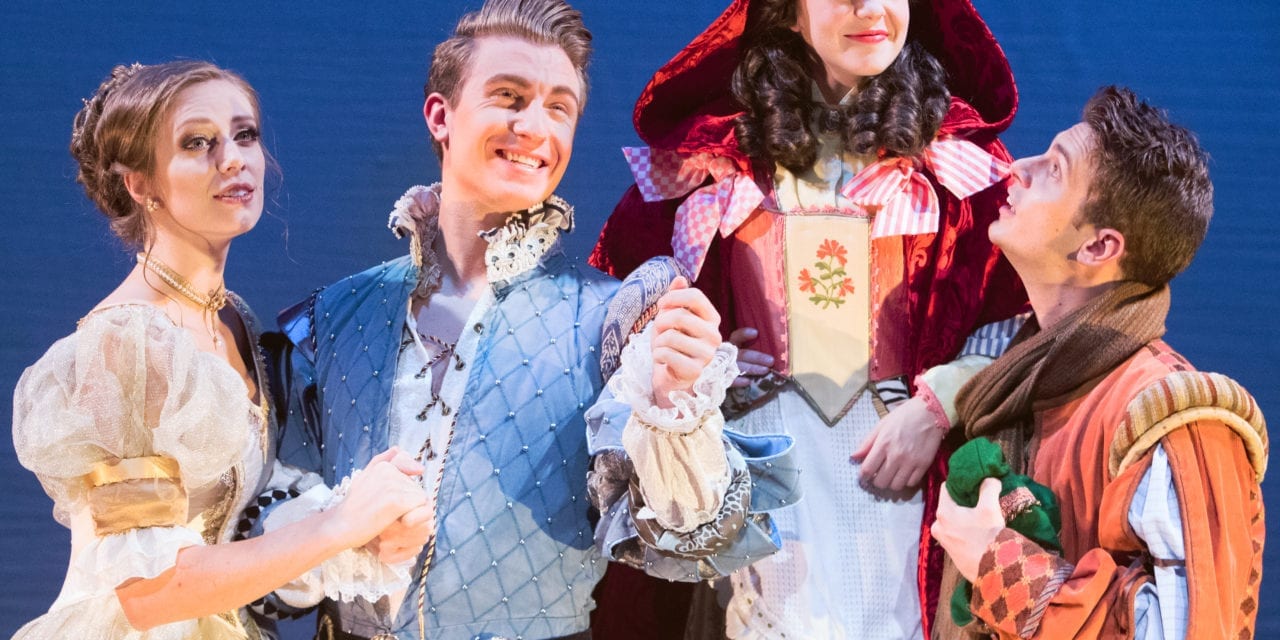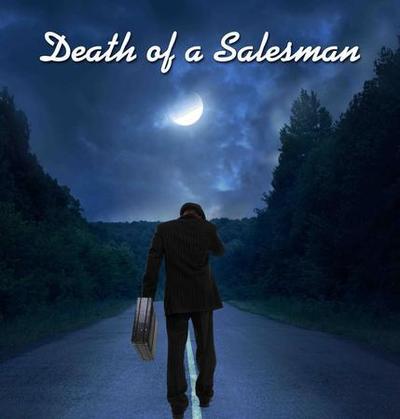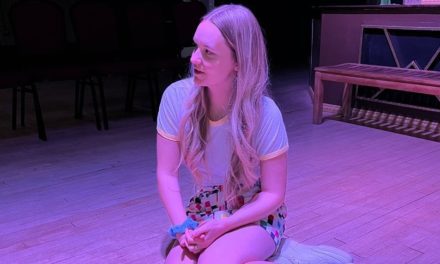PROVO — I’m not going to bury the lede. I loved this show. I confess I love Sondheim—to an evangelical degree, even. So you might think I would be predisposed to like this production of Into the Woods. In fact, the opposite is true. If anything, my zeal for Sondheim makes me inclined to be hard on companies when they don’t do his work justice, and I took my seat at BYU’s Pardoe Theatre with apprehension. Yet, for all that, this is easily the best show I have seen on a Utah stage in the last year, and probably the best realization of a score I’ve heard in longer. I give my sincerest congratulations to this sensational ensemble cast and Dallyn Vail Bayles for a spectacular directorial debut.

Show closes December 9, 2017.
Into the Woods, with a book by James Lapine (to complement Stephen Sondheim’s music and lyrics), is old enough and consecrated enough—the 30th anniversary of its Broadway premiere was just a couple of weeks ago—that reinterpretations or innovative ways to stage it are popular, as is common with Sondheim properties. That isn’t the case in this production. Set designer Benjamin Sanders’s gnarled, mobile trees evoke a labyrinthine forest and Dennis Wright’s costumes (inspired by the art of James Christensen) feature charming, asymmetrical details and contrasting textures. Both are right at home in Bayles’s traditional concept of the show.
Speaking of tradition, Into the Woods intertwines the plots of several fairy tales around a unifying narrative about a baker (played by Joseph Swain) and his wife (played by Channing Weir). They are trying to break a curse of infertility placed upon their house by the witch who lives next door (played by Madison Dennis). With a narrator (played by Jacob Baird) to guide the audience among the various familiar threads, the first act tells how the stories of Cinderella (played by Libby Lloyd), Little Red Riding Hood (played by Hannah Pyper Dalley), Rapunzel (played by Ellora Lattin), and Jack (played by Kristian Huff)—the one with the beanstalk—overlap and affect each other as all the characters go “into the woods” to make their various wishes come true. The second act explores the harsher realities of having our wishes fulfilled and the consequences of the actions people take in pursuit of them.

Hannah Pyper Dalley as Little Red Riding Hood, and Kristian Huff as Jack. Photo by Savanna Richardson/BYU.
When a production like this one decides, either for budgetary or logistical reasons, to forego live musicians, it used to be that the technological limitations of pre-recorded instrumental accompaniments too often undermined talented singers. This has become less of an issue over the years (with the occasional exception), and real orchestral recordings are now commonplace. However, even when the track is of high quality, subpar sound equipment or poor mixing frequently leave the audience’s ears fatigued. I continue to have bad experiences even with venues that have both the resources and know-how at their disposal not to be able to make excuses. With that said, I am pleased to report that BYU’s Into the Woods was, perhaps, the best experience with a taped accompaniment I have ever had. Designer Kristen Tenney ensured that the sound filled out the performance space with breadth and depth. The voices were perfectly integrated in terms of both volume and having the frequency space necessary to take the aural spotlight while not competing with the orchestra track. I was able to forget that the music was pre-recorded and that the actors were all using body mics. The highest praise I can give is that the sound design was practically invisible.
I am even more pleased to add that the singing was worthy of its presentation. Overall, music director Randall Boothe has coached elegant and effortless vocal performances from the cast. Everything was in tune (another sign of the superior sound design), as the actors were clearly hearing each other and the accompaniment well. Moreover, the singing was tension-free and phrased with the subtlety that is only possible when the performers are deeply familiar with even the more difficult chromatic material and confident in their practical knowledge of the prerecorded music.
This last point is particularly important in Into the Woods, which contains a considerable amount of vamping that underscores dialogue. This means that one mistake can snowball very quickly. Yet the cast exhibited keen awareness of the underscoring. For example, at one point in the opening sequence, right before the witch’s rap, I noticed Dennis had picked up her rate of speech. I said to myself, “They’re behind where they should be in the dialogue, and she knows it, so she’s compensating not to miss her cue.” Sure enough, she hit it exactly.
With so much going right in the music and sound department, the few exceptions only underscored how exceptional the experience was. There was a little confusion between the accompaniment and the two actors the first time Cinderella and the Baker’s Wife met in the woods, but Lloyd and Weir quickly recovered. The giant’s voice was difficult to understand through the static and the grating frequencies of the distortion effects, but fortunately she does not have enough dialogue for this to have become a serious issue. The soundtrack forced the actors to rush the end of “No One Is Alone,” however, the orchestra rests for a moment before the last line, so careful use of the pause button by whoever is manning the sound board can remedy this. There is also a lone weak link in the vocal cast, though it is a character part who sings very little, so the negative impact is negligible. And the dramaturg would be wise to fact check Wikipedia when tallying Sondheim’s awards; to say he has “a Laurence Olivier Award” means best musical category wins are included in the total, in which case he has at least four Oliviers (Does one count Candide?) and definitely more than eight Tony Awards. Also, why so much white space in the program for James Lapine?
I don’t have enough superlatives for the ensemble work on display. The actors were well cast, their performances were connected to each other, and the score sat comfortably in their capable voices. Preston Taylor made a delicious meal of the scenery as the Wolf and Cinderella’s Prince, who found an excellent companion in Benjamin Raymant, as Rapunzel’s Prince. I am usually skeptical that having an actor play Milky White, the cow, adds anything to the show, but Cagen Tregeagle showed me it can be done. Lattin made Rapunzel—usually one of the less memorable characters—memorable. I also believed Dalley and Huff as adolescents making their first acquaintance with both puberty and trauma, and they provided a nice counterpoint to Lloyd’s wiser Cinderella. Dennis, in an iconic role, was savvy enough to make her own choices. And at the core of it all, Weir and Swain gave extraordinarily mature, layered, and poignant performances as the Baker’s Wife and the Baker. I don’t know that “It Takes Two” is usually a showstopper, but the strength of their characters’ relationship made it one. Weir’s “Moments in the Woods” and Swain’s “No More” focused shimmering points of character, pathos, and lyricism.
Sondheim’s musicals are not performed often enough in this state. If we don’t count his lyrics-only collaborations (such as West Side Story), Into the Woods is certainly the most produced, probably because people assume its fairy tale roots make it more accessible. Whatever grain of truth there is to that, anyone who thinks Into the Woods is about fairy tales isn’t really paying attention. Furthermore, its popularity notwithstanding, it is deceptively difficult to perform. So don’t pass up the opportunity to see this rare triumph of a production—rare enough to move even this jaded critic.




